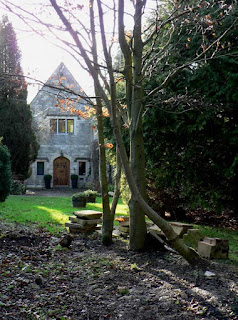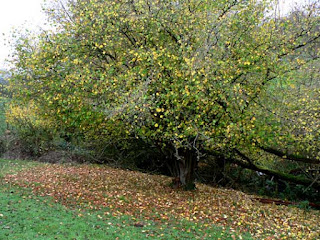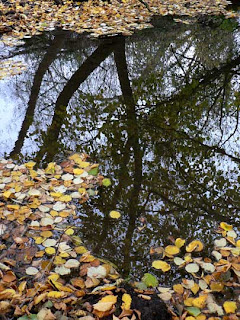 |
| Hazel Mill |
Hazel Mill is a large and attractive old house on the western side of the valley, sitting between the stream and the main road. I'm not clear (and neither is my reference book) whether any of the current house was actually used as a mill, but there is a second building in the garden which definitely was a mill used in the woollen industry during the 19th century. The garden, like most in this valley, is on a steep slope. I'm given the opportunity to explore on my own. Well, I say on my own - in fact, I acquire a companion very early on in the proceedings, in the shape of a black-and-tan dog with a hopeful expression and a tennis ball in his mouth. I harden my heart and resist his attempts to hypnotise me into throwing the ball, because we all know where that leads...
Hazel Mill owns another piece of secret stream, in the shape of the old leat, which runs at right angles to the buildings like a pointing finger, extending out into the fields beyond. I start by walking to the far end of the leat, so that I can find out how and where it joins up with the stream. I read a definition of 'leat' on Wikipedia recently (It's a southwestern word, apparently - these water channels are called other things elsewhere in the country) and this one would seem to be a textbook example. It diverges from the stream in a Y-junction a hundred yards or so from the house, then runs along the contour towards the mill while the stream itself continues down the slope, so that by the time the leat water reaches the mill there's enough height differential to power the mill wheel.
So far, so good. The leat diverges from the stream at the top end of a triangular piece of thick scrub which I remember noting on the Stroud Slad Farm walk, because it was firmly fenced off and I wasn't able to see the stream through the undergrowth. At first, I can’t work out why I couldn’t see this very obvious junction from the other side of the fence, but walking across the apex of the triangle I see the problem – at the apex, the leat forms one side of the triangle and the main stream does appears to form the other, but within a few yards, it has vanished altogether. A fierce combination of thick undergrowth and fences frustrate my attempts to see exactly what has happened to it, but I’m forced to the conclusion that it’s gone underground. Remains of low brick walls on this bit of land which make me wonder if this was another holding pond or other mill stream structure. As with so much of the stream, this area is such a mess of undergrowth and fallen wood, that it's hard to see exactly what’s happening to the ground, but there does appear to be a depression, or gully, where the line of the main stream ought to be.
 |
| View up the leat |
The leat is a good size, three feet wide or more and very busy with water. It's fringed with reedy grasses and clumps of what might be irises (it’s December – no flowers!), ferns and patches of dead leaves. The long view down its length, with the green path winding away from me and the filigree of tree branches, is very attractive. Everything is soft shades of brown and green, gentle and quiet, like today's weather, which is unexpectedly mild and damp after a week of low temperatures and frosts . There's no wind, which is unusual in the valley this year.
My canine friend decides that I’m not a ball person. Maybe a stick will please me? Or a stone? Surely the stone? It’s quite a large stone and after he has lovingly placed it on my foot a couple of times I give up and throw it purely to get him out from under my feet. It falls into the leat, and the dog enthusiastically plunges in after it, drawing my attention to a pile of pale feathers spilling from the opposite bank into the stream. Some bird, a pigeon by the look of it, met its end here recently, or, from another point of view, a fox got a meal which was probably much appreciated at this season.
 |
| Throw it? Please?! |
My friend the dog has found a new, and increasingly muddy, stone which he continues to lay beseechingly before me, but which I’m not going to throw. Really, really not.
There is a point here where you can see a brick edging to the leat, submerged in moss now, but the individual bricks still visible in some places. And here is a glass bottle which has the air of having been in the water for a long time. It looks old, but once it’s in water, it doesn't take long for glass to start looking ancient, so who knows? (I've discovered that a side-effect of the mood of intense looking that these walks generate is the risk of investing unexpected objects with spurious qualities of age and importance!)
 |
| Flounces of fungi |
The dog decides that perhaps his stone is too small to be a worthy offering. He finds a much larger one which, when dropped on my foot repeatedly, does at least get my attention. But it's much too big to throw, and really too big for him to carry around easily. This confirms my opinion of the intelligence of dogs, viz, low, compared with cats. A cat would have wasted no time in getting me to carry the stone.
I've arrived at stone slab in the path, which crosses a channel running out of the leat and down the bank. The channel looks like an overflow, designed to take off surplus water if the level in the leat rises above a certain height. It was presumably intended to flow into the stream, but appears to stop short of the gully where I think the stream should be. So was the main stream originally wider, possibly covering the area where some of the trees are now growing?
 |
| Triple tree sentinel |
The dog has finally got the message that I don’t want the stone. In desperation, he brings me a branch, and when I pick it up (to avoid falling over it) he runs so hilariously in tight circles that I can’t resist throwing it. Good move. He dashes off before the branch has left my hand which means he misses seeing where it falls and ends up running all over the garden looking for it – giving me the chance to get down by the leat and make an undisturbed sound recording of the water running over a single large stone. Otherwise, the leat itself has been very quiet, running smoothly and mostly unimpeded by debris.
I'm now joined by a second dog, larger, browner and more solid, but while apparently glad of my company, this one doesn't seem to require me to throw anything, thank goodness.
 There are now grassy banks on both sides of the water and a board bridge carrying a path across it from higher up. Halfway across the garden, I come to the main event. The water from the leat turns left through a sluice gate, plunges rather spectacularly over a waterfall and flows back into the small stream below, which, augmented by the extra water, clearly becomes the main brook. The stern practicality of the sluice gates is rather undermined by a jauntily-castellated stone wall which makes the waterfall look more like a garden feature than a piece of industrial engineering. Although the water now all goes down the fall, the leat is still visible as a grassy channel, running straight ahead to the old mill building and ending in a fenced-off drop into the mill wheel chamber. Presumably the original idea was that the sluice gates would be closed to build up the water pressure to the mill wheel.
There are now grassy banks on both sides of the water and a board bridge carrying a path across it from higher up. Halfway across the garden, I come to the main event. The water from the leat turns left through a sluice gate, plunges rather spectacularly over a waterfall and flows back into the small stream below, which, augmented by the extra water, clearly becomes the main brook. The stern practicality of the sluice gates is rather undermined by a jauntily-castellated stone wall which makes the waterfall look more like a garden feature than a piece of industrial engineering. Although the water now all goes down the fall, the leat is still visible as a grassy channel, running straight ahead to the old mill building and ending in a fenced-off drop into the mill wheel chamber. Presumably the original idea was that the sluice gates would be closed to build up the water pressure to the mill wheel.And that's the big surprise of today - when I follow the line of the leat to the old mill building, I'm astonished to find that the original mill wheel is still there, suspended under a brick arch and well below me. Visible, but barely photographable, because it's well fenced off for safety. The building itself is in pretty good shape and I'm told that more of the old mill machinery survives inside. I scramble through bramble and nettles to the back of the building but find no windows into the working parts of the mill.
This is another walk that turned out more interesting than expected - the length of the leat, the view of the mill buildings and the mill wheel were all great discoveries. Plus the dog. I definitely hadn’t expected him. My indefatigable friend makes one final attempt to delay my departure by bringing me the very dead remains of a football which I am not at all tempted to throw. I leave him disconsolately punting it around with his nose.
The view from the main road is one of the best of this end of the valley. It strikes me once again that trees are one of the beauties of this time of year, whether close up or in distant view. Close up, they are individual, calligraphic scribbles against a pale winter sky. At a distance, woods and tree-lined field boundaries are now strong, angular shapes, no longer fuzzy-edged with leaf, emphasising the swell and fall of the fields. Every winter I vow to use the opportunity to get to know the different tree species by their shapes so that I can recognise them without reference to their leaves. (And do I do it? Not so far. Still, it’s a good ambition.)
Enough fun for one day - time to go home and wrap Christmas presents.
Google map of the water structure for this walk




































